Kikis Delivery Service
9 /10 1 Votes
100% Rotten Tomatoes Genre Animation, Adventure, Drama Country Japan | 7.9/10 IMDb Duration | |||||||||||||||||||||||||||||||||
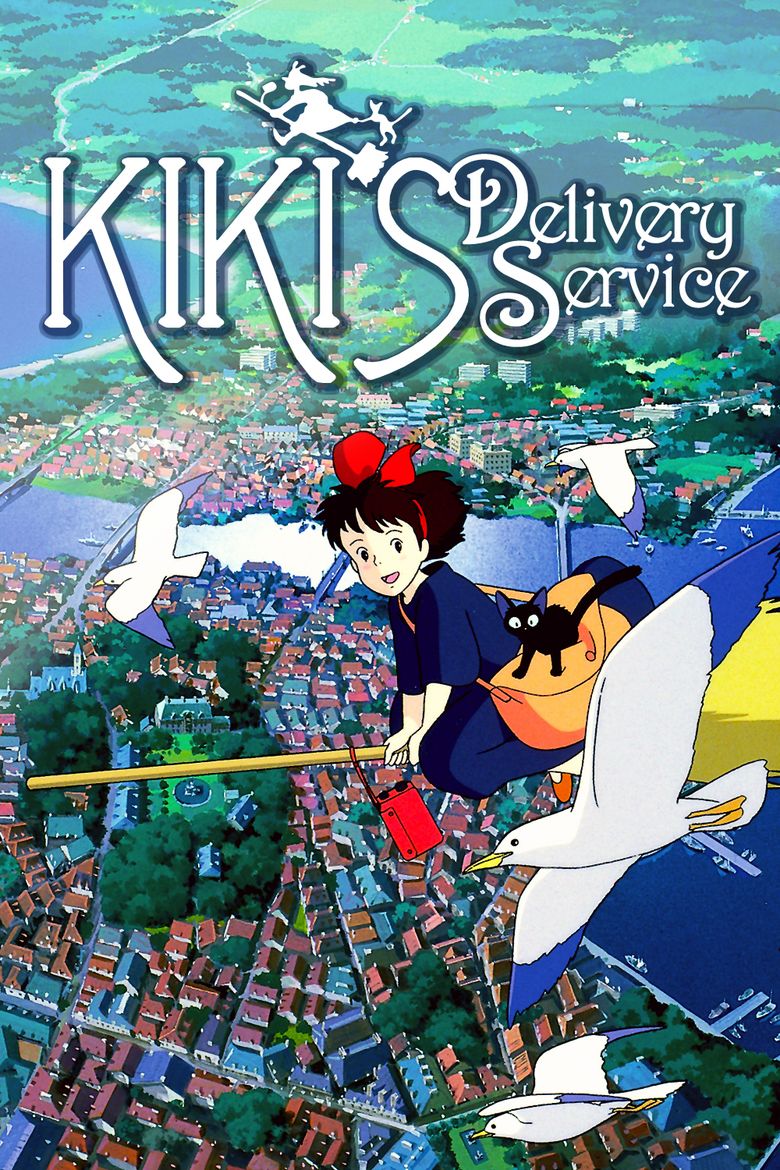 | ||||||||||||||||||||||||||||||||||
Release date July 29, 1989 (1989-07-29) Cast (Kiki / Ursula), (Jiji), (Tombo), (Osono), Mieko Nobusawa (Kokiri, Kiki's mother), Kôichi Miura (Okino, Kiki's Dad)Similar movies Harry Potter and the Order of the Phoenix , Harry Potter and the Half-Blood Prince , Back to the Future , Harry Potter and the Chamber of Secrets , Harry Potter and the Prisoner of Azkaban , Harry Potter and the Philosopher's Stone Tagline I was feeling blue, but I'm better now. | ||||||||||||||||||||||||||||||||||
Kiki's Delivery Service (Japanese: 魔女の宅急便, Hepburn: Majo no Takkyūbin, "Witch's Delivery Service") is a 1989 fantasy anime produced by Studio Ghibli and written, produced, and directed by Hayao Miyazaki as an adaptation of the 1985 novel of the same name by Eiko Kadono. The film tells the story of a young witch, Kiki, who moves to a new town and uses her flying ability to earn a living. According to Miyazaki, the movie portrays the gulf between independence and reliance in teenage Japanese girls.
Contents
- Kiki s delivery service official trailer
- Plot
- Themes and analysis
- Production
- Release
- Differences between versions
- Manga
- Musical
- Reception
- References

Kiki's Delivery Service was released in Japan on July 29, 1989, and won the Animage Anime Grand Prix prize. It was the first Studio Ghibli film released under the 15 year distribution partnership between The Walt Disney Company and Studio Ghibli; Buena Vista Home Video recorded an English dub in 1997, which premiered in United States theaters at the Seattle International Film Festival on May 23, 1998. The film was released on home video in the U.S. and Canada on September 15, 1998.
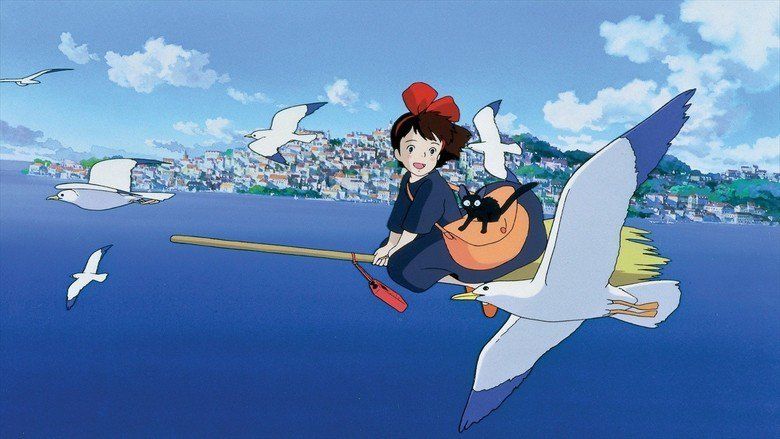
Kiki s delivery service official trailer
Plot
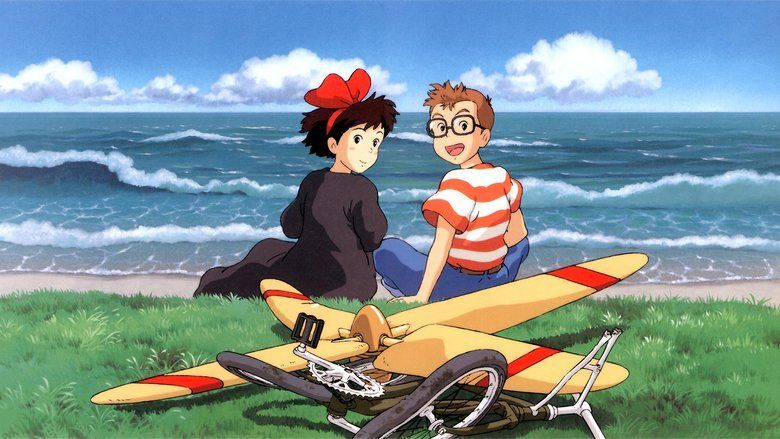
It is traditional for 13-year-old witches to leave home for a year on the night of a full moon to pursue their skill through training.Thirteen-year-old trainee witch Kiki leaves home with her familiar spirit, a talking black cat named Jiji. She flies on her broomstick to the port city of Koriko. While trying to find somewhere to live, Kiki is pursued by Tombo, a geeky boy obsessed with aviation who admires her flying ability.
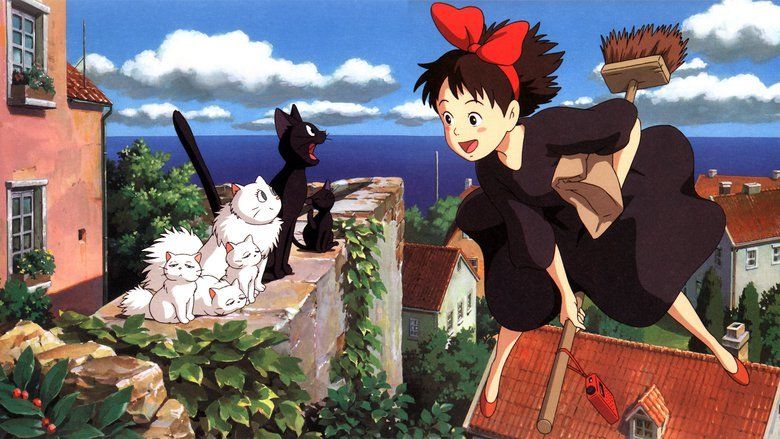
In exchange for accommodation, Kiki helps Osono, the kindly and heavily pregnant owner of a bakery. She opens a "Witch Delivery Business", delivering goods by broomstick. Her first delivery goes badly; she is caught in wind and loses the black cat toy she is supposed to deliver. Jiji pretends to be the toy until Kiki can retrieve the real item. She finds it in the home of a young painter, Ursula, who repairs and returns it to Kiki so she can complete the delivery and rescue Jiji.
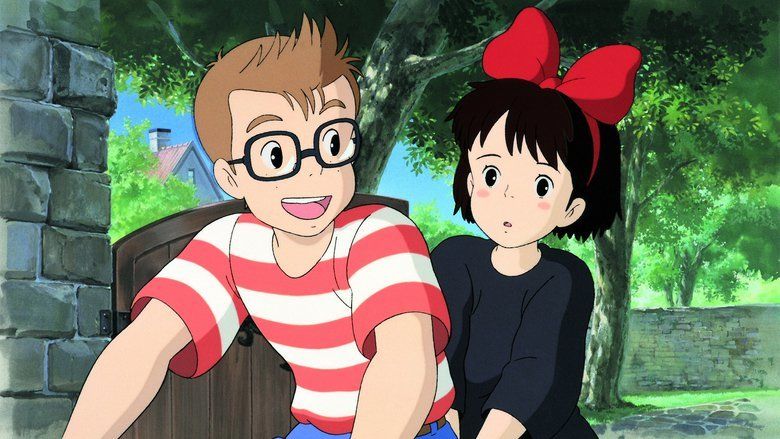
Kiki accepts a party invitation from Tombo, but is delayed by her work and, exhausted, falls ill. When she recovers, Osono clandestinely arranges for Kiki to see Tombo again by assigning her a delivery addressed to him. After Kiki apologizes for missing the party, Tombo takes her for a test ride on the flying machine he is working on fashioned from a bicycle. Kiki warms to Tombo but is intimidated by his friends, and walks home.
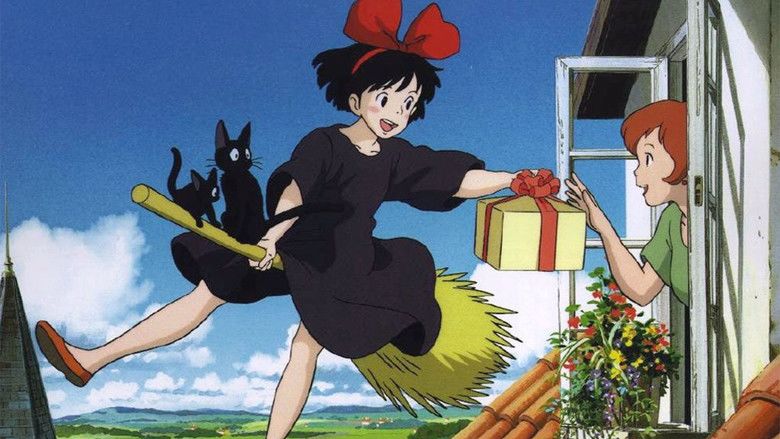
Kiki becomes depressed and discovers she can no longer understand Jiji, who has befriended a pretty white cat. She has also lost her flying ability and is forced to suspend her delivery business. Kiki has a surprise visit from Ursula, who determines that Kiki's crisis is a form of artist's block. Ursula suggests that if Kiki can find a new purpose, she will regain her powers.

While Kiki is visiting a customer, she witnesses an airship accident on television which leaves Tombo hanging from one of the drifting vessel's mooring lines. Kiki regains her flying power and manages to rescue him. She regains her confidence, resumes her delivery service, and writes a letter home saying that she and Jiji are happy.
Themes and analysis
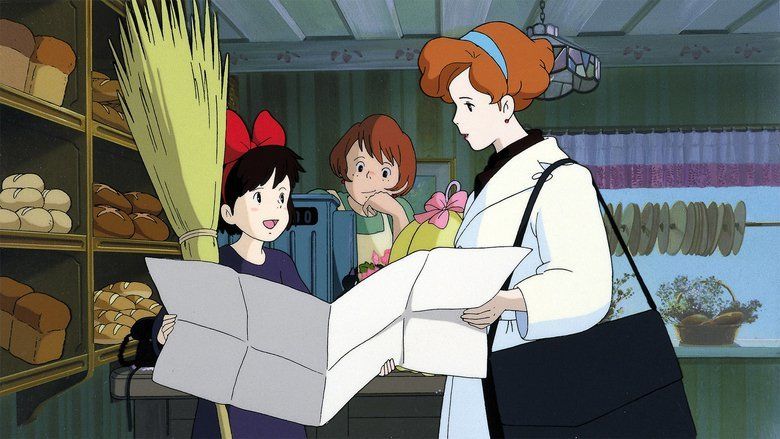
Several aspects of Kiki's behavior and appearance have been the focus of commentary. One major theme is Kiki's transition into adulthood. While being raised by loving parents who support her independence, Kiki is faced with problems common in adolescence such as finding a job, seeking acceptance, and taking care of herself. The concept of vulnerability is also examined closely in the film. Critic Mark Schilling noted a scene during Kiki's first night away from home, staying with the bakers: Early in the morning, she quickly steps out of her room into the outhouses and peers out to see the husband, Fukuo, stretching his muscles. After he leaves the scene, Kiki rushes back to her room and slams the door behind her while gasping for air. "The scene does absolutely nothing to advance the plot and the humor in it is low...but...it wordlessly — and eloquently — expresses Kiki's youth, vulnerability, and isolation."
Another theme is the transition from traditional to contemporary. Kiki is shown to balance both of these qualities. For instance, Kiki observes the tradition of witches wearing black, but adorns her hair with a bright red bow. Kiki also engages in other traditional methods, such as baking with a wood-burning stove and flying her mother's old broom.
Kiki's loss of her ability to fly is also the subject of discussion. It is considered the worst crisis Kiki has to face during the film. The loss of flight reflects the harm dealt to Kiki by her own self-doubts. However, this hardship is what causes Kiki to realize that being vulnerable does not always lead to failure. In essence, the experience demonstrates that such vulnerability can help one learn valuable lessons and better understand oneself. Kiki in fact does not face any external adversaries in the film, though some have argued that the crashing dirigible is a feasible example. Kiki also loses her ability to talk with her cat, Jiji.
In relation to Kiki's portrayal as a witch, some have drawn comparisons to historical or contemporary views on witches and witchcraft. The film incorporates some conventions from fairy-tales such as a black cat companion for Kiki, Kiki's use of a broom for flight, and her black dress. While girls with magical powers are common in Japanese television, Miyazaki noted that, "the witchcraft has always merely been the means to fulfill the dreams of young girls. They have always become idols with no difficulties." In contrast, Kiki cannot use her powers as a means of wish fulfillment.
Kiki has also been compared to other characters in Miyazaki's films. While there are overt differences in demeanor between Kiki and San from Princess Mononoke, a character who is motivated by anger, both characters take control over their own lives. This theme of remarkable independence is also seen in Miyazaki's earlier works, such as in Nausicaä in Nausicaä of the Valley of the Wind. Kiki is also compared to Chihiro of Spirited Away in the sense that they are both young girls attempting to seek independence without being rebellious. Chihiro is able to develop her independence through her friends and parents, just as Kiki leaves her village with her parents' blessings.
Production
In 1987, Group Fudosha asked Kadono's publishers for the rights to adapt Kadono's novel into a feature film directed by either Hayao Miyazaki or Isao Takahata of Studio Ghibli. However, both of the chosen directors were busy, working on My Neighbor Totoro and Grave of the Fireflies respectively. Miyazaki accepted the role of producer while the studio continued to search for a director. Near the end of Totoro's production, members of Studio Ghibli were being recruited as senior staff for Kiki's Delivery Service. The character design position was given to Katsuya Kondo, who was working with Miyazaki on Totoro. Hiroshi Ohno, who would later work on projects such as Jin-Roh, was hired as art director at the request of Kazuo Oga.
Miyazaki chose Sunao Katabuchi as director. Katabuchi had worked with Miyazaki on Sherlock Hound; Kiki's Delivery Service would be his directorial debut. Studio Ghibli hired Nobuyuki Isshiki as script writer, but Miyazaki was dissatisfied by the first draft, finding it dry and too divergent from his own vision of the film. Since the novel was based in a fictional country in northern Europe, Miyazaki and the senior staff went to research landscapes and other elements of the setting. Their main stops were Stockholm and the Swedish island of Gotland.
Upon their return to Japan, Miyazaki and the creative team worked on conceptual art and character designs. Miyazaki began significantly modifying the story, creating new ideas and changing existing ones. Majo no Takkyūbin, the original children's book by Kadono that the movie was based on, is very different from Miyazaki's finished film. Kadono's novel is more episodic, consisting of small stories about various people and incidents Kiki encounters while making deliveries. Kiki overcomes many challenges in the novel based on "her good heart" and consequently expands her circle of friends. She faces no particular traumas or crises. Many of the more dramatic elements, such as Kiki losing her powers or the airship incident at the film's climax, are not present in the original story. However, in order to more clearly illustrate the themes of struggling with independence and growing up in the film, Miyazaki intended to have Kiki face tougher challenges and create a more potent sense of loneliness. One such challenge is Kiki's sudden loss of ability to fly. This event is only loosely paralleled in the novel, in which Kiki's broom breaks and merely requires her to fix it. Miyazaki remarked, "As movies always create a more realistic feeling, Kiki will suffer stronger setbacks and loneliness than in the original". Kadono was unhappy with the changes that made between the book and film, to the point that the project was in danger of being shelved at the screenplay stage. Miyazaki and Toshio Suzuki, the producer of Ghibli, went to the author's home and invited her to the film's studio. After her visit to the studio, Kadono decided to let the project continue.
Miyazaki finished the rough draft of the screenplay in June 1988 and presented it in July 1988. It was at this time that Miyazaki revealed that he had decided to direct the film, because he had influenced the project so much. Kiki's Delivery Service was originally intended to be a 60-minute special, but expanded into a feature film running 102 minutes after Miyazaki completed storyboarding and scripting it.
The word takkyūbin (宅急便, literally "home-fast-mail") in the Japanese title is a trademark of Yamato Transport, though it is used today as a synonym for takuhaibin (宅配便, "home-delivery-mail"). The company not only approved the use of its trademark, though its permission was not required under Japanese trademark laws, but also enthusiastically sponsored the film, as the company uses a stylized depiction of a black mother cat carrying her kitten as its corporate logo.
Release
The first official English dub of Kiki's Delivery Service was produced by Carl Macek of Streamline Pictures at the request of Tokuma Shoten for Japan Airlines' international flights. Kiki was portrayed by voice actress Lisa Michelson. This dub is only available in the Ghibli Laserdisc Box Set.
Kirsten Dunst voiced Kiki in Disney's 1997 English dub, released in 1998. This dub was also Canadian comedian and actor Phil Hartman's last voice-acting performance (as Jiji) before his death in 1998. The dub is dedicated to his memory.
The Disney English dub of Kiki's Delivery Service premiered at the Seattle International Film Festival on May 23, 1998. It was released to VHS on September 15, 1998. A few weeks later, Disney released another VHS of the movie, this time with the original Japanese soundtrack and with both English and Japanese subtitles. A Laserdisc version of the English dub also became available at this time. The Region 1 DVD was released in August 16, 2005 alongside Spirited Away and Castle in the Sky. It was again reissued on Region 1 DVD in March 2010 along with My Neighbor Totoro and Castle in the Sky as a tribute to the home release of Ponyo. This version of this 2010 release was slightly edited to match the original Japanese version, removing some of Hartman's ad-libbed lines and replacing Sydney Forest's opening and ending songs with the original Japanese songs. 2 years later, on 1 July 2013, StudioCanal released a Blu-ray, followed by a Grave of the Fireflies release except in that same format, only in the United Kingdom. Walt Disney Studios Home Entertainment released Kiki's Delivery Service on Blu-ray Disc on November 18, 2014. GKIDS will re-issue the film on Blu-ray & DVD on October 17, 2017.
Differences between versions
Disney's English dub of Kiki's Delivery Service contained some changes, which have been described as "pragmatic". The changes were approved by Miyazaki and Studio Ghibli.
There are a number of additions and embellishments to the film's musical score, and several lavish sound effects over sections that are silent in the Japanese original. The extra pieces of music, composed by Paul Chihara, range from soft piano music to a string-plucked rendition of Edvard Grieg's In the Hall of the Mountain King. The original Japanese opening theme is "Rouge no Dengon" (ルージュの伝言, Rūju no Dengon, "Message of Rouge"), and the ending theme is "Yasashisa ni Tsutsumareta nara" (やさしさに包まれたなら, "Wrapped in Kindness"), both performed by Yumi Matsutoya (credited as Yumi Arai). The original opening and ending theme songs were replaced by two new songs, "Soaring" and "I'm Gonna Fly", written and performed for the English dub by Sydney Forest.
The depiction of the cat, Jiji, changed significantly in the Disney version. In the Japanese version Jiji is voiced by Rei Sakuma, while in the English version Jiji is voiced by comedian Phil Hartman. In Japanese culture, cats are usually depicted with feminine voices, whereas in American culture their voices are more gender-specific. A number of Hartman's lines exist where Jiji simply says nothing in the original. Jiji's personality is notably different between the two versions, showing a more cynical and sarcastic attitude in the Disney English version as opposed to cautious and conscientious in the original Japanese.
In the original Japanese script, Kiki loses her ability to communicate with Jiji permanently, but the American version adds a line that implies that she is once again able to understand him at the end of the film. Miyazaki has said that Jiji is the immature side of Kiki, and this implies that Kiki, by the end of the original Japanese version, has matured beyond talking to her cat.
More minor changes to appeal to the different teenage habits of the day include Kiki drinking hot chocolate instead of coffee and referring to "cute boys" instead of to "the disco".
However, as outlined in the Release notes section above, the 2010 English release is once again quite different; many elements have reverted more towards the original Japanese version. For example, JiJi once again does not talk at the very end, and many of the sound effects added to the "traditional" English version have been removed.
The English subtitled script used for the original VHS subbed release and the later DVD release more closely adheres to the Japanese script, but still contains a few alterations. Tokuma mistakenly believed the Streamline dub was an accurate translation of the film and offered it to Disney to use as subtitles. As a result, several additions from the dub appear in the subtitles regardless of whether or not they are present in the film.
In Spain, Kiki was renamed "Nicky" because in Castilian Spanish the phonetically similar "quiqui" is commonly used in the slang expression "echar un quiqui", which means "to have intercourse". The film was re-titled Nicky la aprendiz de bruja (Nicky the Apprentice Witch).
Manga
A manga book series using stills from the film was published in Japan by Tokuma Shoten. An English translation was published in 2006 by VIZ Media, in 4 volumes.
Musical
In 1993, a musical version of the story was produced. Yukio Ninagawa wrote the script and Kensuke Yokouchi directed the show. The role of Kiki was portrayed by Youki Kudoh and the role of Tombo was portrayed by Akira Akasaka. Akasaka was replaced by Katsuyuki Mori within the year. A cast recording was produced by the original cast, and the show was revived in 1995 and 1996.
Reception
Kiki's Delivery Service premiered on July 29, 1989 in Japanese theaters. The total distribution receipts were ¥2,170,000,000 (US$18,000,000). The film proved to be a financial success and was the highest-grossing film in Japan in 1989. The Japanese DVD was the best selling anime DVD for February 7, 2001.
Buena Vista Home Video's VHS release became the 8th-most-rented title at Blockbuster stores during its first week of availability. This video release also sold over a million copies.
On September 4, 1998, Entertainment Weekly rated it as Video of the Year, and on September 12, 1998, it was the first video release to be reviewed as a normal film on Siskel and Ebert rather than on the "Video Pick of the Week" section. Gene Siskel of the Chicago Tribune and Roger Ebert of the Chicago Sun-Times gave it "two thumbs up" and Ebert went on to rank it as one of the best animated films of 1998. The film ranked #12 on Wizard's Anime Magazine's list of the "Top 50 Anime released in North America". Other reviews were very positive as well. On the review aggregator website Rotten Tomatoes, Kiki's Delivery Service has a score of 97% based on 29 reviews with an average rating of 7.8/10, the website's consensus reads, "Kiki's Delivery Service is a heartwarming, gorgeously-rendered tale of a young witch discovering her place in the world." The conservative Christian group Concerned Women for America boycotted Kiki's Delivery Service screenings and released a press release on February 5, 1998, titled "Disney Reverts to Witchcraft in Japanese Animation". Calling for a boycott of The Walt Disney Company, the group said the company "is still not family friendly, but continues to have a darker agenda".
References
Kiki's Delivery Service WikipediaKikis Delivery Service IMDbKikis Delivery Service Rotten TomatoesKikis Delivery Service themoviedb.org
